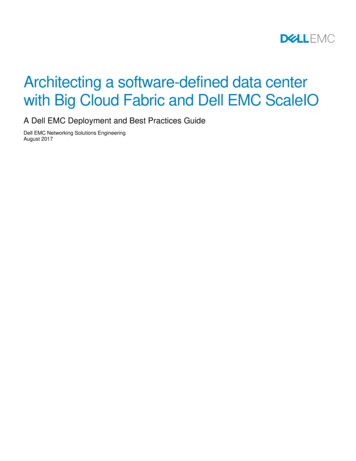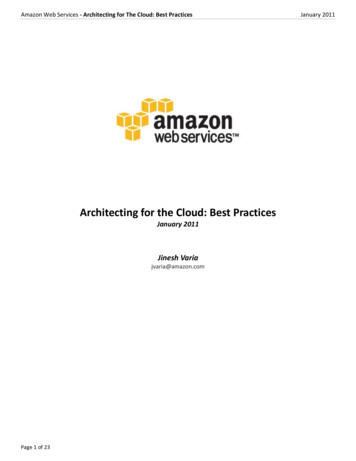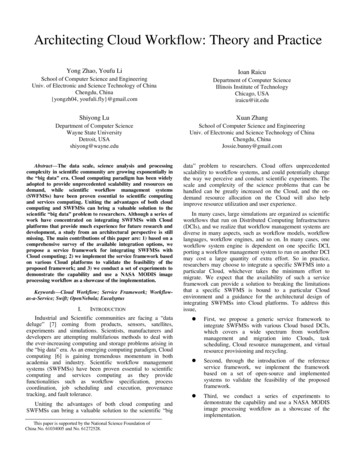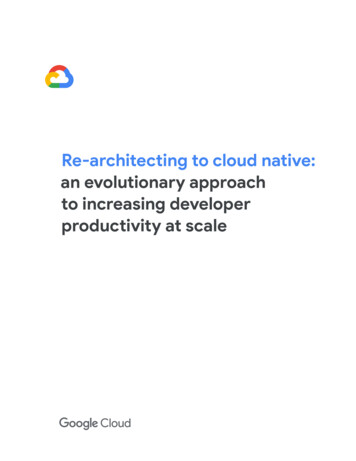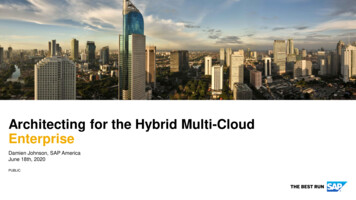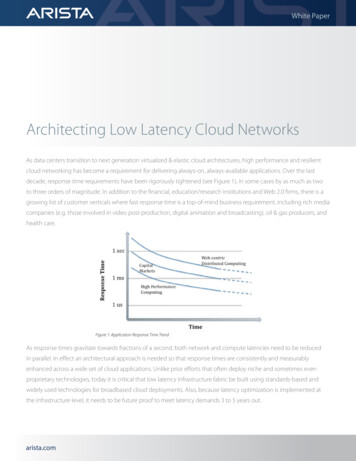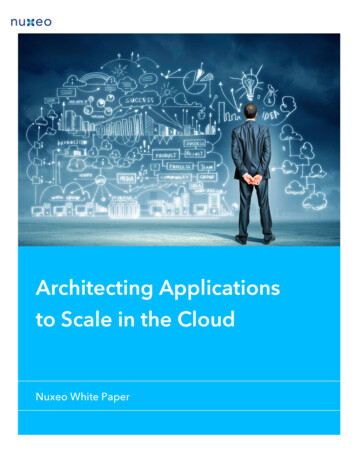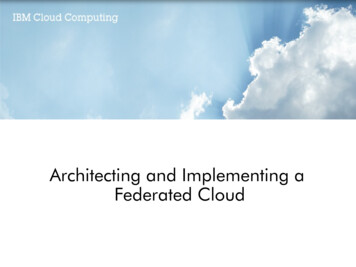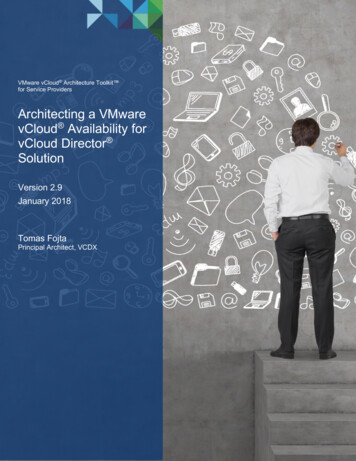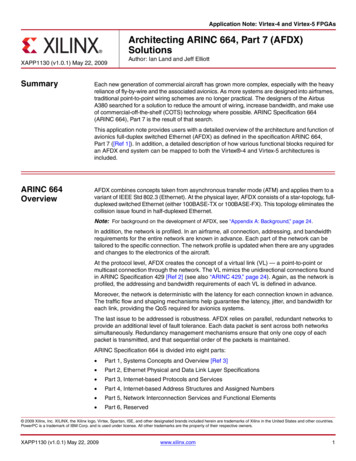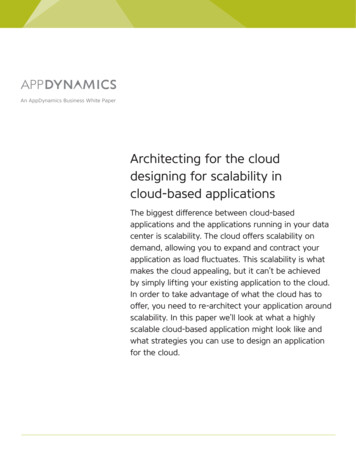
Transcription
An AppDynamics Business White PaperArchitecting for the clouddesigning for scalability incloud-based applicationsThe biggest difference between cloud-basedapplications and the applications running in your datacenter is scalability. The cloud offers scalability ondemand, allowing you to expand and contract yourapplication as load fluctuates. This scalability is whatmakes the cloud appealing, but it can’t be achievedby simply lifting your existing application to the cloud.In order to take advantage of what the cloud has tooffer, you need to re-architect your application aroundscalability. In this paper we’ll look at what a highlyscalable cloud-based application might look like andwhat strategies you can use to design an applicationfor the cloud.
Sample architecture of a cloud-based applicationDesigning an application for the cloud often requires re-architecting yourapplication around scalability. The figure below shows what the architecture of ahighly scalable cloud-based application might look like.Figure 1. Sample Cloud-Based ArchitectureThe Client Tier: The client tier contains user interfaces for your target platforms,which may include a web-based user interface, a mobile user interface, or even athick client user interface. There will typically be a web application that performsactions such as user management, session management, and page construction. Butfor the rest of the interactions the client makes RESTful service calls into the server.Services: The server is composed of both caching services, from which the clientsread data, that host the most recently known good state of all of the systems ofrecord, and aggregate services that interact directly with the systems of record fordestructive operations (operations that change the state of the systems of record).Systems of Record: The systems of record are your domain-specific servers thatdrive your business functions. These may include user management CRM systems,purchasing systems, reservation systems, and so forth. While these can be newsystems in the application you’re building, they are most likely legacy systems withwhich your application needs to interact. The aggregate services are responsiblefor abstracting your application from the peculiarities of the systems of record andproviding a consistent front-end for your application.Architecting for the cloud sesigning for salability in cloud-based applications2
ESB: When systems of record change data, such as by creating a new purchaseorder, a user “liking” an item, or a user purchasing an airline ticket, the systemof record raises an event to a topic. This is where the idea of an event-drivenarchitecture (EDA) comes to the forefront of your application: when the systemof record makes a change that other systems may be interested in, it raises anevent, and any system interested in that system of record listens for changes andresponds accordingly. This is also the reason for using topics rather than usingqueues: queues support point-to-point messaging whereas topics support publishsubscribe messaging/eventing. If you don’t know who all of your subscribersare when building your application (which you shouldn’t, according to EDA) thenpublishing to a topic means that anyone can later integrate with your application bysubscribing to your topic.Whenever interfacing with legacy systems, it is desirable to shield the legacysystem from load. Therefore, we implement a caching system that maintains thecurrently known good state of all of the systems of record. And this caching systemutilizes the EDA paradigm to listen to changes in the systems of record and updatethe versions of the data it hosts to match the data in the systems of record. This is apowerful strategy, but it also changes the consistency model from being consistentto being eventually consistent. To illustrate what this means, consider posting anupdate on your favorite social media site: you may see it immediately, but it maytake a few seconds or even a couple minutes before your friends see it. The datawill eventually be consistent, but there will be times when the data you see and thedata your friends see doesn’t match. If you can tolerate this type consistency thenyou can reap huge scalability benefits.NoSQL: Finally, there are many storage options available, but if your applicationneeds to store a huge amount of data it is far easier to scale by using a NoSQLdocument store. There are various NoSQL document stores, and the one you choosewill match the nature of your data. For example, MongoDB is good for storingsearchable documents, Neo4J is good at storing highly inter-related data, andCassandra is good at storing key/value pairs. I typically also recommend some formof search index, such as Solr, to accelerate queries to frequently accessed data.Let’s begin our deep-dive investigation into this architecture by reviewing serviceoriented architectures and REST.REpresentational State Transfer (REST)The best pattern for dividing an application into tiers is to use a service-orientedarchitecture (SOA). There are two main options for this, SOAP and REST. There aremany reasons to use each protocol that I won’t go into here, but for our purposesREST is the better choice because it is more scalable.Architecting for the cloud sesigning for salability in cloud-based applications3
REST was defined in 2000 by Roy Fielding in his doctoral dissertation and is anarchitectural style that models elements as a distributed hypermedia system thatrides on top of HTTP. Rather than thinking about services and service interfaces,REST defines its interface in terms of resources, and services define how we interactwith these resources. HTTP serves as the foundation for RESTful interactionsand RESTful services use the HTTP verbs to interact with resources, which aresummarized as follows:– GET: retrieve a resource– POST: create a resource– PUT: update a resource– PATCH: partially update a resource– DELETE: delete a resource– HEAD: does this resource exist OR has it changed?– OPTIONS: what HTTP verbs can I use with this resourceFor example, I might create an Order using a POST, retrieve an Order using a GET,change the product type of the Order using a PATCH, replace the entire Order usinga PUT, delete an Order using a DELETE, send a version (passing the version as anEntity Tag or eTag) to see if an Order has changed using a HEAD, and discoverpermissible Order operations using OPTIONS. The point is that the Order resource iswell defined and then the HTTP verbs are used to manipulate that resource.In addition to keeping application resources and interactions clean, using the HTTPverbs can greatly enhance performance. Specifically, if you define a time-to-live(TTL) on your resources, then HTTP GETs can be cached by the client or by an HTTPcache, which offloads the server from constantly rebuilding the same resource.REST defines three maturity levels, affectionately known as the Richardson MaturityModel (because it was developed by Leonard Richardson):1. Define resources2. Properly use the HTTP verbs3. Hypermedia ControlsThus far we have reviewed levels 1 and 2, but what really makes REST powerful islevel 3. Hypermedia controls allow resources to define business-specific operationsor “next states” for resources. So, as a consumer of a service, you can automaticallydiscover what you can do with the resources. Making resources self-documentingenables you to more easily partition your application into reusable components (andhence makes it easier to divide your application into tiers).Sideline: you may have heard the acronym HATEOAS, which stands for Hypermedia asthe Engine of Application State. HATEOAS is the principle that clients can interact withan application entirely through the hypermedia links that the application provides. Thisis essentially the formalization of level 3 of the Richardson Maturity Model.Architecting for the cloud sesigning for salability in cloud-based applications4
RESTful resources maintain their own state so RESTful web services (the operationsthat manipulate RESTful resources) can remain stateless. Stateless-ness is a corerequirement of scalability because it means that any service instance can respondto any request. Thus, if you need more capacity on any service tier, you can addadditional virtual machines to that tier to distribute the load. To illustrate why this isimportant, let’s consider a counter-example: the behavior of stateful servers. Whena server is stateful then it maintains some client state, which means that subsequentrequests by a client to that server need to be sent to that specific server instance. Ifthat tier becomes overloaded then adding new server instances to the tier may helpnew client requests, but will not help existing client requests because the load cannotbe easily redistributed.Furthermore, the resiliency requirements of stateful servers hinder scalabilitybecause of fail-over options. What happens if the server to which your client isconnected goes down? As an application architect, you want to ensure that clientstate is not lost, so how to we gracefully fail-over to another server instance? Theanswer is that we need to replicate client state across multiple server instances (or atleast one other instance) and then define a fail-over strategy so that the applicationautomatically redirects client traffic to the failed-over server. The replicationoverhead and network chatter between replicated servers means that no matter howoptimal the implementation, scalability can never be linear with this approach.Stateless servers do not suffer from this limitation, which is another benefit toembracing a RESTful architecture. REST is the first step in defining a cloud-basedscalable architecture. The next step is creating an event-driven architecture.Event-Driven ArchitectureAn event-Driven Architecture (EDA) is one of the keys to scalability. The core conceptunderlying EDA is the idea that systems notify other systems of changes usingevents and those events are delivered asynchronously. EDA promotes loose couplingbecause the producer of an event does not need to know anything about its varioussubscribers – it defines the structure of its events and publishes them at appropriatetimes. Consumers can be added at any point: they subscribe to receive notificationsand process them when they arrive. This is illustrated in figure 2.Figure 2. Event-Driven ArchitectureArchitecting for the cloud sesigning for salability in cloud-based applications5
Aside from being a good strategy for loosely coupling systems, a key factor thatmakes EDA scalable is its asynchronous communication paradigm. Asynchronouscommunication means that consumers process events as they are able to: if anapplication becomes saturated by excessive load, an asynchronous application mayslow down as events back up, but it will not go down. Consider processing statusupdates on a social media site: as load increases the events may back up, but theconsumers only consume them at the rate they can. So under heavy load you mayhave to wait five minutes to learn that I’m at the laundromat, but that’s hardly theend of the world.Additionally, EDA is a poster child for the cloud because as events back up, it iseasy to start up additional event listeners to process the backed up events. Eventlisteners can leverage the elasticity that the cloud provides.EDA is the architecture, but it does not dictate the implementation. Most often EDA isimplemented on top of an enterprise service bus (ESB) and uses topics as the meansof communication. As mentioned earlier, topics are preferred over queues becausethey operate in a publish-subscribe manner. A message producer publishes an eventand anyone interested in that event can process it. If we used queues then every timea new subscriber was added, the producer would need to be updated to publish tothe new consumer – this is an example of tight coupling, which we want to avoid.ESBs are the most common choice to implement EDA, but they are not the onlychoice. In practice, while ESBs are advanced and have been developed by smartprogrammers, they are often difficult to maintain and can cause performancebottlenecks, so some architects have searched back through Fieldings’ RESTfuldissertation to discover the potential for using Atom feeds for event publishing.In this model, when something meaningful happens in a component, instead ofpublishing a message to a topic, the component publishes the message to an Atomfeed. Atom is an HTTP-based replacement for RSS (Really Simple Syndication)designed to publish things like newsfeeds, but because of its HTTP-basedimplementation it is very RESTful in nature. When using Atom as a replacement foran ESB, instead of subscribing to topics, a consumer instead polls the component’sAtom feed. It then processes messages at its own rate and returns for moremessages when it is ready.Because there are typically not too many subscribers to a single component’sAtom feed, the resultant load is not significant and each consumer controls its owncapacity. Additionally, if a consumer goes down there is no concern that it has lostmessages because it simply continues from where it left off. Finally, Atom feedsprovide a source of history for a component that would have otherwise requiredquite a bit of effort to implement.Architecting for the cloud sesigning for salability in cloud-based applications6
Atom is not a panacea, however. If your application is sensitive to latency then Atomis not a good choice. An ESB delivers a message as soon as it is ready but the Atomfeed is subject to the polling interval of its consumers. Additionally, when there arecomponents that do not generate many messages, there is the wasted overheadof continually polling the component. If latency is not an issue for your application,using an Atom feed to facilitate EDA is a simple, elegant, and fault-tolerant solution.Figure 3 shows a graphical comparison of using an ESB and using an Atom Feed toimplement an EDA application.Figure 3. ESB versus Atom as an EDA ImplementationDeploying to the cloudThis paper has presented an overview of a cloud-based architecture and provideda cursory look at REST and EDA. Now let’s review how such an application can bedeployed to and leverage the power of the cloud.Architecting for the cloud sesigning for salability in cloud-based applications7
Deploying RESTful servicesRESTful web services, or the operations that manage RESTful resources, aredeployed to a web container and should be placed in front of the data store thatcontains their data. These web services are themselves stateless and only reflectthe state of the underlying data they expose, so you are able to use as manyinstances of these servers as you need. In a cloud-based deployment, start enoughserver instances to handle your normal load and then configure the elasticity ofthose services so that new server instances are added as these services becomesaturated and the number of server instances is reduced when load returns tonormal. The best indicator of saturation is the response time of the services,although system resources such as CPU, physical memory, and VM memory aregood indicators to monitor as well. As you are scaling these services, always becognizant of the performance of the underlying data stores that the services arecalling and do not bring those data stores to their knees.Figure 4 shows that the services that interact with Document Store 1 can bedeployed separately, and thus scaled independently, from the services that interactwith Document Store 2. If Service Tier 1 needs more capacity then add more serverinstances to Service Tier 1 and then distribute load to the new servers.Figure 4. Scaling RESTful tiersArchitecting for the cloud sesigning for salability in cloud-based applications8
Deploying an ESBThe choice of whether or not to use an ESB will dictate the EDA requirements foryour cloud-based deployment. If you do opt for an ESB, consider partitioning theESB based on function so that excessive load on one segment does not take downother segments. This segmentation is shown in figure 5.Figure 5. ESB SegmentationThe importance of segmentation is to isolate the load generated by System 1 fromthe load generated by System 2. Or stated another way, if System 1 generatesenough load to slow down the ESB, it will slow down its own segment, but notSystem 2’s segment, which is running on its own hardware. In our initial deploymentwe had all of our systems publishing to a single segment, which exhibited just thisbehavior! Additionally, with segmentations, you are able to scale each segmentindependently by adding multiple servers to that segment (if your ESB vendorsupports this).ConclusionCloud-based applications are different from traditional applications because theyhave different scalability requirements. Namely, cloud-based applications mustbe resilient enough to handle servers coming and going at will, must be looselycoupled, must be as stateless as possible, must expect and plan for failure, andmust be able to scale from a handful of server to tens of thousands of servers.There is no single correct architecture for cloud-based applications, but this paperpresented an architecture that has proven successful in practice making use ofRESTful services and an event-driven architecture. While there is much, much moreyou can do with the architecture of your cloud application, REST and EDA are theTry it FREE atwww.appdynamics.comAppDynamics, Inc.www.appdynamics.combasic tools you’ll need to build a scalable application in the cloud.Copyright 2014 AppDynamics, Inc. All rights reserved. The termAPPDYNAMICS and any logos of AppDynamics are trademarked orregistered trademarks of AppDynamics, Inc.
Architecting for the cloud sesigning for salability in cloud-based applications 2 Sample architecture of a cloud-based application Designing an application for the cloud often requires re-architecting your application around scalability. The figure below shows what the architecture of a highly scalable

